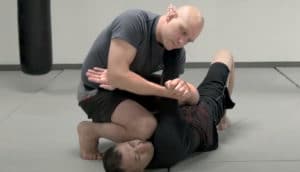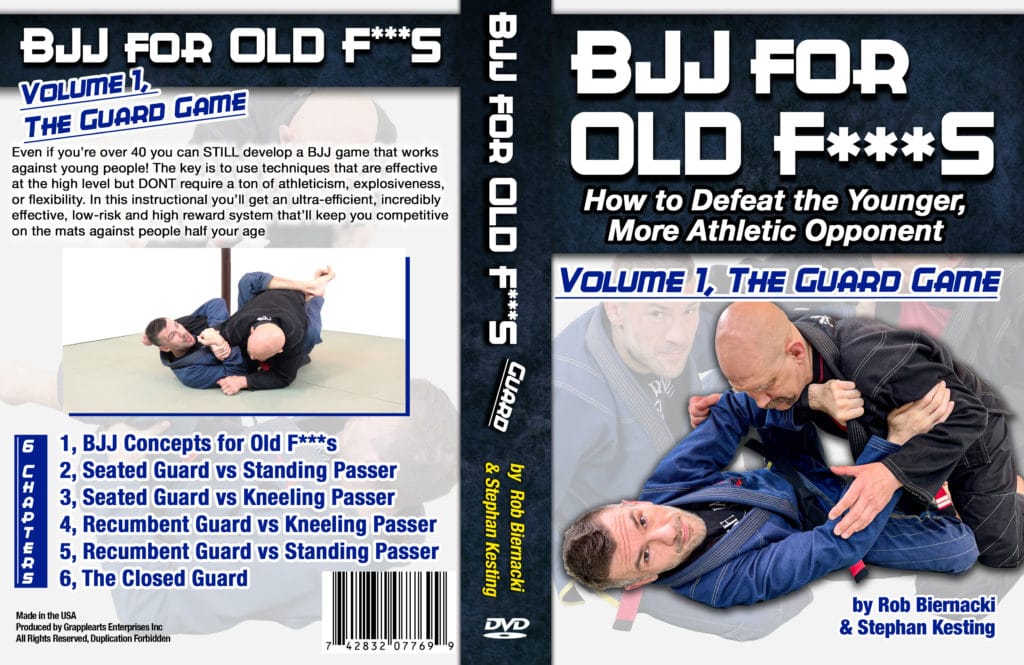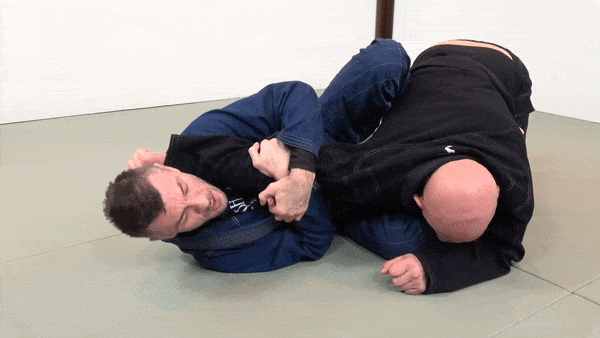
The reverse armbar from closed guard is a great way to attack from the closed guard, especially against a younger, more athletic opponent. Using this submission is a two step process….
The first step is to get him under control and take away his movement privileges.
The second step is to methodically advance your position until he’s all out of options and you finish the submission.
When you do that successfully: congratulations! You’ve just crushed a millennial’s spirit, heard his lamentations, and drank his tears!
Here’s a video I put on Youtube taking you through the shoulder clamp into the reverse armbar attack…
Note that this is actually a two-part video. The first half is about the shoulder clamp position, and the second half is about the reverse armbar itself…
Achieving and Controlling the Shoulder Clamp Position (0:00 to 6:02)
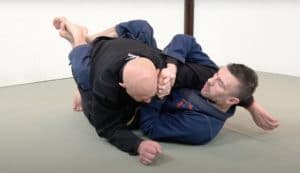
The Shoulder Clamp Control Position
The closed guard is great but it still allows your opponent to use his arms to frame you and then pop up to his feet to break your guard open.
The shoulder clamp control from closed guard allows you to control not only his hips (with your legs) but also his shoulder and upper arm (with your arms).
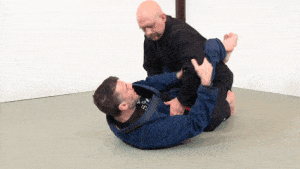
Elbow Flare to Shoulder Clamp Grip
One of the easiest ways to get to this control position is by flaring his elbow outwards using both of your hands and then swimming for the shoulder clamp grip. You’ll get a near side underhook, then link your hands while cutting down on the back of his armpit and deltoid with your forearm.
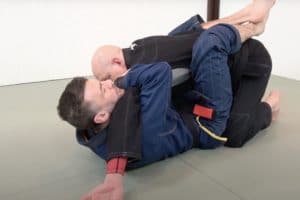
Details of the Shoulder Clamp Position
Key points to have an effective shoulder clamp include…
- Lock your hands together with a palm to palm grip, turning the thumb of the underhooking arm down towards the ground.
- Cut your top wrist down onto the deltoid of his shoulder
- Bring your chin over his triceps/elbow area to stop him from rotating his arm out
- Internally rotate his shoulder by turning his elbow towards the ceiling
- Shrug your top shoulder and raise your top elbow up high
- Drive his shoulder down and lift the rest of his arm up
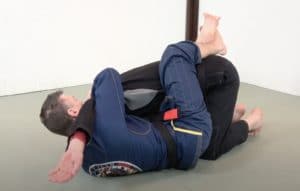
Escape Your Hips to the Side
Once you have the grip established then escape your hips out to the side. This further disrupts his alignment and makes it much harder for him to bring his head back over your torso to escape his arm.
Now your strongest weapons are pointed at him and his weapons are pointed at the ground. Also his base and his structure are heavily compromised in this position, which is a green light to attack with sweeps, submissions and backtakes.
Adjusting and Finishing the Reverse Armbar Submission (6:02 to 11:17)
The second part of the video above shows you how to move into the reverse armbar submission (aka the cutting armbar and/or the razor lock) to tap him out and end the match.
Once again let’s look at this in two parts… Moving from the shoulder to the elbow, and then actually finishing the submission!
The Reverse Armbar Part 1, Adjusting Your Control from the Shoulder to the Elbow
To get into the finishing position for this submission you need to migrate your hands from his shoulder down his arm towards his elbow while maintaining rotational control over his arm.
To create room for this transition first bring your feet onto his hips on both sides, and slide your hips backwards. Then bring your knees against your opponent’s ribs for distance control
There are two basic ways to move to the elbow grip…
The first method is to simply slide your grip from the shoulder to the elbow.
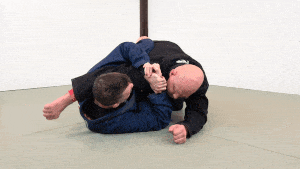
Method 1: Sliding Your Grip From Shoulder to Elbow
Slightly loosen the same palm to palm grip that you used to control the shoulder clamp and slide both hands, still linked, back to the elbow joint.
This is simple but not easy to accomplish. It requires sensitivity in your arms to maintain rotational control over his arm as you adjust your grip backwards. As such it is probably the more advanced method.
The second method is to move your hands one at a time.
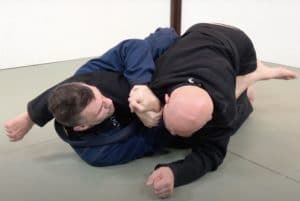
Both Hands Control the Shoulder Initially…
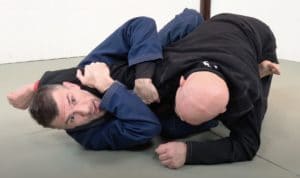
One Hand Moves Back to Control the Elbow…
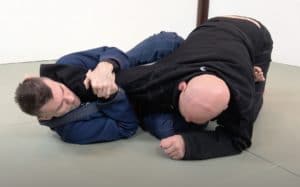
Both Hands Migrate to the Elbow
Moving your hands one at a time like this allows you to maintain more control over his arm. It limits his ability to twist out of the submission.
The Reverse Armbar Part 2, Finishing the Submission
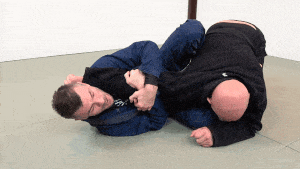
Applying the Reverse Armlock
Once you’ve got your feet on your opponent’s hips and your hands migrated down to his elbow it’s time to finish the actual armlock!
The key here is to escape your hips backwards and crunch your upper body forward. Essentially this is the exact opposite movement your hips would do if they were doing a regular armbar, which makes sense given that this the reverse armbar!
A common error here is to have his arm tight against your chest; you don’t want this. You need an empty space in front of your body into which you then pull his elbow.
What If He Turns His Arm and Escapes?
When you’re first learning this submission it’s very common for your opponent to point his thumb to the sky, roll his elbow inward, and then escape his arm.
You can stop this escape before it happens by controlling the rotation of his arm and by using your lower body frames to stop him from coming back over top of you.
But even if you screw up on those things you can still take advantage of his escape. For example, if you anticipate the escape and pass his arm across your body as he’s wriggling it out then it sets up a direct route to his back (and to other submissions).
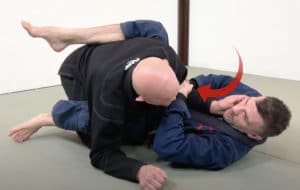
Your Opponent Turns His Elbow Down and His Thumb Up…
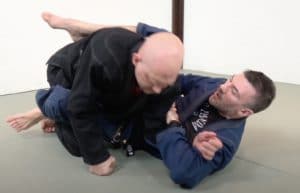
This Brings His Arm Across His Body…
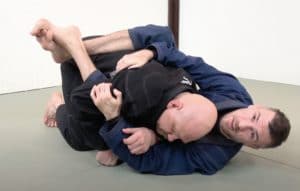
And Exposes a Route to His Back!
Tap out some young punks with the reverse armbar for me!
Cheers,
Stephan Kesting
P.S. Don’t write off this submission like I did. When I was first shown this technique from the top position I was pretty sure it would never ever work. Then I used it to win two different BJJ tournaments in a row.
P.P.S. This technique is from the brand new instructional BJJ for Old F***s featuring Rob Biernacki and Stephan Kesting.
We chose this technique (and many others) because it’s a great way to limit the athletic advantage that young punks have on the mat. And who doesn’t like tapping out younger, stronger, more athletic people using technique, strategy and cunning?
BJJ for Old F***s is available in 3 different formats…
- Online streaming format,
- A set of 5 high-quality physical DVDs, or
- App format for iOS and Android devices.
Click here for more info about this instructional and how to get it.



